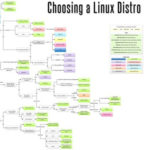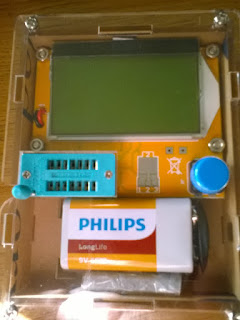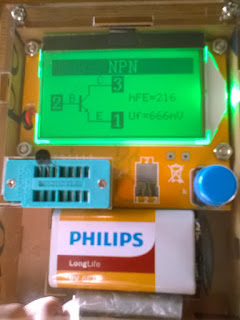 M328 LCR-T4 an updated version of M328 LCR Transistor tester.
M328 LCR-T4 an updated version of M328 LCR Transistor tester.
I wrote about the original M328 Chinese kit sometime ago, which I had to build to prove to myself that VK3YE's capacitance offset error problem was a calibration error:
http://g1kqh.blogspot.co.uk/2015/02/building-m328-component-tester-1.html
http://g1kqh.blogspot.co.uk/2015/02/building-m328-component-tester-2.html
However there is now a newer pre built SMD version (M328 LCR-T4) which came into my hands recently, all that you have to do is kit it together with a prebuilt case and a 9V battery NO SOLDERING: (Cost less than £8 inc case inc delivery).
This version has the advantage of being ready built with ZIF skt, and supports a better LCD full sized display!
I like this for it's ability to identify "any" transistor, or diode, you seem to throw at it. Displaying the gain figures of, and whatever way around the device is plugged into the ZIF socket, it has the ability to identify the pin out configuration, and if it is PNP or NPN, or even a FET. so you do not have to keep getting the semiconductor book out or downloading the data sheet for the pin data.
I thought this version was so good! I got G4WIF of the GQRP club recently to include it into the new Tribal Knowledge - Test Equipment document here
Steve, G1KQH, is a regular contributor to AmateurRadio.com and writes from England. Contact him at [email protected].
 LHS Episode #203: Choosing Your Linux Distribution
LHS Episode #203: Choosing Your Linux Distribution
 In Episode #203 of Linux in the Ham Shack, your hosts take a deep dive into the factors you should consider when choosing a Linux distribution that suits you. These are tips you can use when your computer will be used for personal use, ham shack use, office use or any other type of computing. Thank you for listening!
In Episode #203 of Linux in the Ham Shack, your hosts take a deep dive into the factors you should consider when choosing a Linux distribution that suits you. These are tips you can use when your computer will be used for personal use, ham shack use, office use or any other type of computing. Thank you for listening!
73 de The LHS Crew
Russ Woodman, K5TUX, co-hosts the Linux in the Ham Shack podcast which is available for download in both MP3 and OGG audio format. Contact him at [email protected].
 AmateurLogic 113: IR CAD Weather Meter
AmateurLogic 113: IR CAD Weather Meter
AmateurLogic.TV Episode 113 is now available for download.
Peter experiments with infrared remote control. Tommy fiddles with Tinkercad. Emile becomes an amateur weather scientist. George tests a variety of components with an ohmmeter.
1:22:57
George Thomas, W5JDX, is co-host of AmateurLogic.TV, an original amateur radio video program hosted by George Thomas (W5JDX), Tommy Martin (N5ZNO), Peter Berrett (VK3PB), and Emile Diodene (KE5QKR). Contact him at [email protected].
 Amateur Radio Weekly – Issue 189
Amateur Radio Weekly – Issue 189
Fox-1D launched, initial telemetry received
Initial telemetry values appear nominal.
AMSAT
Ham Radio 360: FaradayRF – Open Source Digital Radio
We pull back the veil and get a glimpse of the future… “Challenging the notion of making a contact.”
Ham Radio 360
ARRL revises changes to Articles of Association and By-Laws
The ARRL Executive Committee is scaling back proposed changes to its Articles of Association and By-Laws.
CQ Magazine
Monitoring power meters with an RTL-SDR
And with one simple command, I was reading the power (and probably water) meters for my entire neighborhood.
kroy.io
Baofeng APRS PTT controller
Baofeng radios trigger the ptt by shorting the sleeves of the two audio connectors. I isolated the audio lines with two audio transformers and set up the pi to trigger the transistor with a GPIO pin.
awsh.org
TyMD380toolz for Tytera MD-380
Now that I have the worldwide database of DMR users loaded onto the radio, its like having caller ID on my HT.
K0NR
Amateur astronomers track secretive spy satellites for fun
If Zuma is still up there, there’s a small group of people who will be ready and watching for it to reappear in a week, when its projected orbit should bring it out of Earth’s shadow and into the daylight.
Popular Science
Why a maritime forecast is so beloved in the United Kingdom
This weather report has been making waves for 150 years.
Atlas Obscura
Video
How Hedy Lamarr changed the world with radio
An overview of frequency hopping.
ARRL
A tip to keep track of charged batteries
This is a little cheap tip I picked up to keep track of the status of multiple charges batteries.
WI9LL
N4KGL FM satellite setup
This is my gear I am using for operating on FM amateur radio satellites like SO-50.
N4KGL
Pocket DATV
Minimal Digital TV chain: Transmitter and Receiver. Hardware used on Tx: PiZero, Picam, LimeSDR Mini. Hardware used on Rx: Raspberry Pi 2, RTL-SDR
YouTube
Amateur Radio Weekly is curated by Cale Mooth K4HCK. Sign up free to receive ham radio's most relevant news, projects, technology and events by e-mail each week at http://www.hamweekly.com.
 LHS Episode #202: The Weekender
LHS Episode #202: The Weekender
 Welcome to the first edition of LHS "The Weekender." We will be recording these every other Thursday night. They are a round-table done on Mumble wherein we talk about stuff that interests us, recommendations on fun things to do for the weekend: Stuff to do, stuff to eat, stuff to drink. Lots of stuff. You're encouraged to join on future episodes. Check the IRC chat room topic or the homepage for information on the Mumble connection and join us for a fun time. Cheers.
Welcome to the first edition of LHS "The Weekender." We will be recording these every other Thursday night. They are a round-table done on Mumble wherein we talk about stuff that interests us, recommendations on fun things to do for the weekend: Stuff to do, stuff to eat, stuff to drink. Lots of stuff. You're encouraged to join on future episodes. Check the IRC chat room topic or the homepage for information on the Mumble connection and join us for a fun time. Cheers.
73 de The LHS Crew
Russ Woodman, K5TUX, co-hosts the Linux in the Ham Shack podcast which is available for download in both MP3 and OGG audio format. Contact him at [email protected].
 The Icom 7610 is here!!
The Icom 7610 is here!!
The long awaited Icom 7610 is now available, the spec’s on this rig are very impressive. I would say that for all this rig offers it is priced VERY COMPETITIVELY! I won’t list the spec’s just provide this link that gives you the run down……..see what you think?

Mike Weir, VE9KK, is a regular contributor to AmateurRadio.com and writes from New Brunswick, Canada. Contact him at [email protected].
 LETTER TO ARRL REGARDING CURRENT BOARD OF DIRECTOR ACTIVITIES
LETTER TO ARRL REGARDING CURRENT BOARD OF DIRECTOR ACTIVITIES
The following open letter to the ARRL Board of Directors and Leadership is in concert with many others coming from current members in response to the activities occurring at the ARRL Leadership level.
To join in and voice your thoughts, please visit:
![]()
(More information is found after the following open letter)
To: All ARRL Directors and Officers
From: NW7US
Many actions–policy and governance–taken by the League’s leadership over the past two years trouble me. Formalization of specific actions planned for the Board meeting on January 19, 2018, specifically worries me.
At this time, any action taken by the ARRL Board of Directors cause me concern. As a result of this, I add my name to those seeking that the Board delay consideration of any ByLaw changes at the January 19 Board meeting.
In particular, I strongly urge you to:
1. Reject any proposal to allow the President and individual Vice-Presidents to vote as Directors.
2. Reject any provision that allows expulsion of an ARRL member “for cause” without delineated criteria.
3. Reject any provision that allows expulsion of any Director, Vice-Director of Officer for bringing ARRL into “disrepute” without specific criteria.
4. Reject any provision that reduces Members’ ability to recall a sitting Director.
5. Reject any current or proposed provision that allows the Board to disqualify candidates for elected office without full disclosure of the reasons for such disqualification.
6. Reject any proposal that would allow the Board to designate replacements for Directors instead of appointing an elected Vice Director or other elective processes.
7. Reject any current or proposed provision that allows censure, removal or other disciplines of a Director for revealing or openly discussing any view expressed at a Board meeting that is not consistent with the Board’s action.
8. Adopt a policy that elected Directors, and Vice Directors are not “personnel” for the purposes of declaring that any information about removal or disqualification is confidential and may not be released.
It is crucial that ARRL remain a solidly democratic, membership-based organization with principles of openness and accessibility through our elected Directors. I urge you to vote per my wishes at the January 19 meeting.
Beyond these issues of governance, I am concerned about the policy-making process of the ARRL leadership–leadership that I feel has become much less Member-driven, and that no longer reflects the needs of the Membership.
Ham radio is in a time of transition. The ARRL must focus on the issues that make a difference for the future success of the hobby.
73, Tomas Hood / NW7US
More information about this effort:
myARRLvoice is an independent grassroots group of amateur radio operators working on behalf of our fellow Members of the American Radio Relay League (ARRL), monitoring the activity of its leadership and advocating change to optimize the organization’s effectiveness in matters of policy and governance, and to foster ethical and competent stewardship.
myARRLvoice acts as a vehicle for ARRL Members to make their voices heard on matters of governance and policy, and to participate in the policy-setting process, holding our elected and appointed leaders accountable. We strive to make the activities of ARRL leadership more transparent by insisting on the creation and dissemination of records of the deliberations and actions of all ARRL Boards, Committees, and the operational Executive Team.
myARRLvoice believes that good ARRL stewardship can only be achieved through a check and balance system that includes the watchful eye of the Membership.
Visit the website at www.myarrlvoice.org
Visit, subscribe: NW7US Radio Communications and Propagation YouTube Channel

















